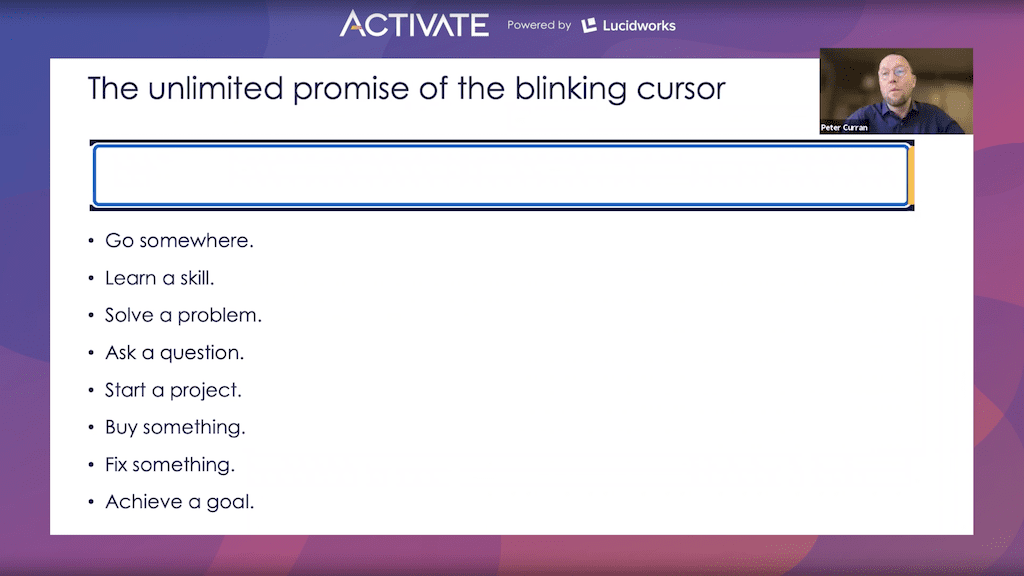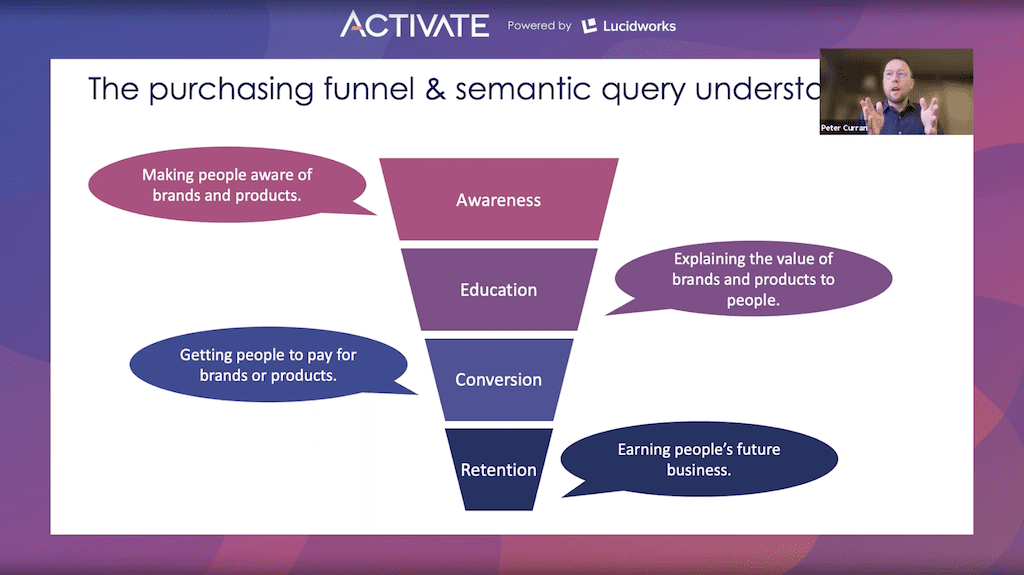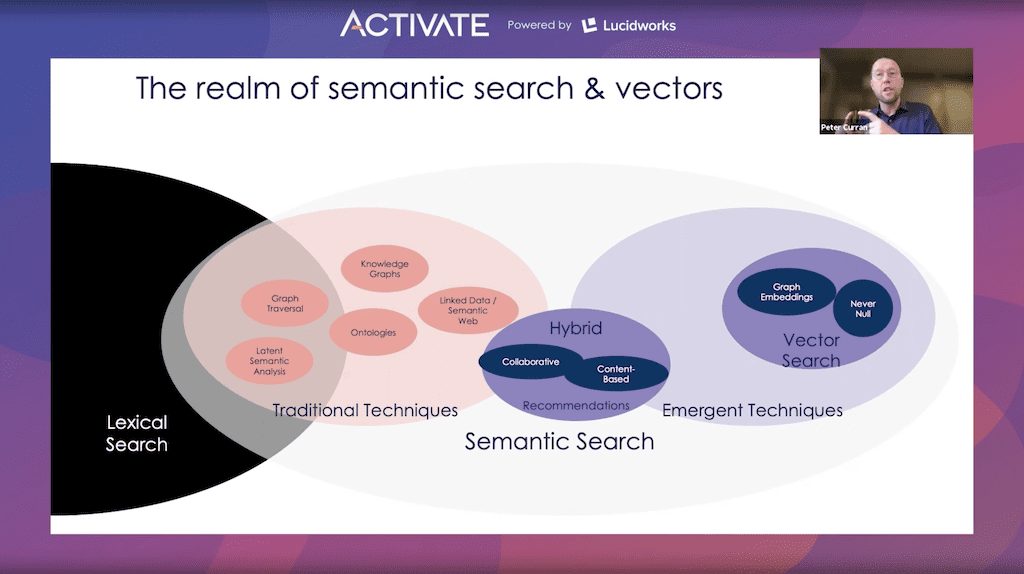Bei der Produktentdeckung geht es um Ziele, nicht um Abfragen
Während der Activate hielt Peter Curran, General Manager of Digital Commerce bei Lucidworks, einen Vortrag über die Bedeutung von Kundenzielen in Bezug auf die Produktfindung. Curran erläuterte das Potenzial, das Marken haben, um ihren Kunden relevante Produkte und Empfehlungen zu liefern, indem sie das Ziel des Kunden verstehen – und nicht einfach nur Ergebnisse liefern, die mit den Suchbegriffen übereinzustimmen scheinen.
Wenn sich Marken nicht mehr auf lexikalische Suchmethoden (mit Schwerpunkt auf Schlüsselwörtern) verlassen, sondern auf die semantische Vektorsuche (mit Schwerpunkt auf Zielen und Bedeutung), können sie ihren Benutzern und Kunden relevantere Suchergebnisse liefern.

Das Suchfeld birgt unglaubliche Versprechen und Möglichkeiten. Es kann das Tor zum nächsten Urlaub eines Benutzers oder zu einem begehrten Paar Turnschuhe sein. Die Suchleiste kann jemanden dazu bringen, eine neue Fähigkeit zu erlernen oder eine brennende Frage zu beantworten. Alle diese Möglichkeiten haben einen gemeinsamen Nenner: das Ziel des Benutzers.

Leider ist die allzu häufige Realität, die viele Benutzer mit dem Suchfeld erleben, Betrug. Sie bleiben auf halber Strecke eines Projekts stecken, werden zum falschen Produkt geführt oder finden nur mehr Fragen statt Antworten. Oft müssen die Benutzer das Suchfeld immer wieder neu abfragen, bis das System endlich ihr Ziel verstanden hat. Eine Diskrepanz zwischen dem Ziel des Benutzers und den von ihm verwendeten Schlüsselwörtern wird offensichtlich. An diesem Punkt wird der Benutzer darauf trainiert, sich an das Suchfeld anzupassen, obwohl es eigentlich andersherum sein sollte.
Überprüfen Sie, wie Ziele in den traditionellen Trichter passen
Wir können das Konzept des „Erreichens eines Ziels“ verstehen, wenn wir uns ansehen, wie es innerhalb des E-Commerce-Kauftrichters funktioniert. Wir sind wahrscheinlich alle mit den Hauptelementen des Trichters vertraut. Die meisten Suchfelder im E-Commerce sind ganz darauf ausgerichtet, den Nutzer zur Konversion oder zur Weiterbildung zu bewegen. Das ist zwar technisch nicht falsch, aber die Marken berücksichtigen bei der Suche nicht das Ziel des Käufers, sondern nur die von ihm verwendeten Schlüsselwörter. Die Gefahr besteht darin, dass das Suchfeld das Gesamtbild der Absicht des Käufers nicht berücksichtigt, da es nicht die relevantesten Produkte und Informationen anzeigt.

Understanding Intent in Action
Let’s say a user wants to make a key lime pie. A common occurrence is the user navigates to the website of their choice that hosts recipe and ingredient content, and searches “key lime pie” in the search box. A very typical result may involve a number of products related to the keywords popping up – driving the user toward the conversion point of the funnel. This could include the ingredients, a recipe, or even buying a key lime pie outright.
Depending on the website and content it hosts, the user may also be moved back and forth between education and conversion. The problem arises when the search box can’t easily point the user in the direction they are trying to go, and it falls to the user to learn how to navigate the website and potentially skip the search box altogether.

Say a different user is looking to make a very straightforward transaction for a specific drink using a popular coffee app. It makes perfect sense for the user to navigate to the search box and begin typing in the name of the specific drink they want to purchase. What we see is the search is capable of offering paths to conversion, however it misses the goal of getting the specific drink the user is looking for. As a result, the user ends up having to once again adapt to how the app organizes content apart from the search box, such as a “Browse” option.

Semantic Vector Searches Solves for Intent
Traditionally, search boxes have relied on lexical search, which focuses exclusively on keywords. This form of search has resulted in the frequent gaps in understanding of a user’s larger search goal. This is where semantic vector search can make a real difference. Semantic search as a term has been in use since at least the early 00s, but today refers to search based on meaning – with the inherent element of focusing on goals.
Within semantic vector search is a set of emergent technologies built around deep learning. The method of organizing content in a database is called a vector space. With vector space, the ability to organize and present content is not limited to two or three dimensions, but fifty, a hundred, three hundred dimensions. Ideas, products, documents, users, segments – a vast array of content can be plotted and retrieved in one location.

Incredible things are possible with semantic vector search functionality. For example, a user can search for a product that is not contained within a brand’s catalogue, and still receive results that are relevant to the intention of the user. Going even further, the user could search in a language that the catalogue is not translated to, and still receive results that are relevant to their search in the language of the catalogue itself.
When applying the potential of semantic and vector search to our previous examples, we might start to see more intuitive search box results. Instead of having to navigate an entire website to understand how to put together a key lime pie recipe, the search box can understand the user’s goal of making one and deliver them to the exact content they would require. Instead of being trained to use the coffee app, the search box can have the ability to deduce what the user is looking for and give us the same depth of options as the “Browse” function.
What’s the moral of these stories?
- Relevancy is the most important user experience consideration in search.
- The user’s goal is not always inherently understandable with keywords alone.
- Even great websites struggle to understand where the user is in the buying journey.
- Relevancy is often subjective and contextual, but ambiguity is detectable.
Deep learning and semantic vector search offer superior query understanding in ambiguous scenarios. User interfaces need to evolve to respond to ambiguity and offer users viable paths in their search journey. When we go beyond the lexical search and deterministic browse paradigms that ecommerce has traditionally relied on, we can address digital business challenges that have long required tedious curation and data work. By focusing on the user goal through semantic vector search, we can create better outcomes that connect customers with the products and information they need.
Learn more about our managed cloud service, Never Null, to see how your brand can deliver better product discovery experiences to meet your shoppers’ goals.